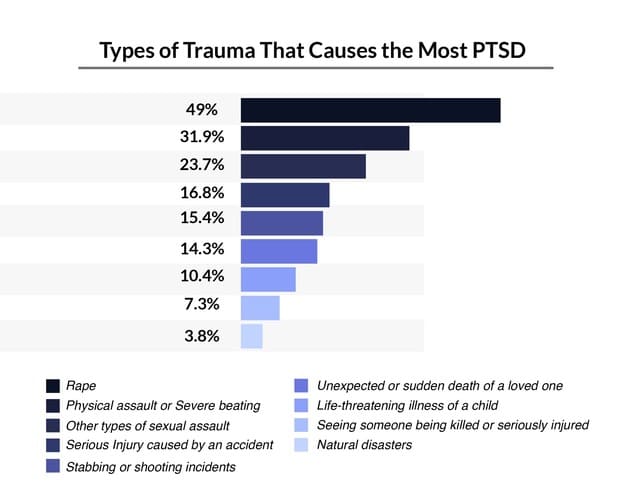PTSD Assessment
3 Min Free PTSD Assessment
Who Can Benefit From This PTSD Assessment?
Individuals who have experienced or witnessed a traumatic event and are experiencing symptoms such as flashbacks, nightmares, avoidance of reminders of the event, hypervigilance, or negative changes in mood or cognition.
This includes individuals who have experienced combat, sexual assault, physical assault, accidents, natural disasters, or other traumatic events.
Family members or caregivers of individuals who have experienced trauma may also benefit from an assessment, as it can provide insight into how to support and help their loved one.
Additionally, healthcare professionals, such as psychologists, psychiatrists, and social workers, may use a PTSD assessment to diagnose and develop treatment plans for their patients.
Overall, anyone who is experiencing symptoms of PTSD or is concerned about their mental health after a traumatic event can benefit from a PTSD assessment.

PTSD Assessment Accuracy

The accuracy of a PTSD assessment depends on several factors, including the type of assessment used, the experience and qualifications of the professional conducting the assessment, and the individual being assessed. A comprehensive PTSD assessment typically involves multiple methods of evaluation, including clinical interviews, self-report measures, and psychological tests. By using multiple sources of information, a more accurate and comprehensive assessment can be obtained.
It is important to note that PTSD can be a complex and multifaceted condition, and not all individuals who have experienced trauma will develop PTSD. Additionally, some individuals may have symptoms that are similar to PTSD but are caused by other factors, such as anxiety or depression.
Types of PTSD Assessment
Diagnostic interviews:
A healthcare professional will conduct a comprehensive interview with the individual to gather information about their symptoms, history, and behavior. Examples of diagnostic interviews used for PTSD include the Clinician-Administered PTSD Scale (CAPS-5) and the Structured Clinical Interview for DSM-5 (SCID).
Self-report measures:
These are standardized questionnaires that ask individuals to report their symptoms and experiences. Examples of self-report measures used for PTSD include the PTSD Checklist (PCL-5) and the Impact of Event Scale-Revised (IES-R).
Clinician-administered scales:
These are rating scales completed by a healthcare professional to assess the severity of an individual’s symptoms. Examples of clinician-administered scales used for PTSD include the Clinician-Administered PTSD Scale (CAPS-5) and the Structured Clinical Interview for DSM-5 (SCID).
Behavioral observations:
A healthcare professional may observe the individual in different settings, such as at home or work, to assess their behavior and symptoms.
Psychological tests:
These tests are used to assess cognitive abilities, attention, and other aspects of the individual’s functioning. Examples of tests used for PTSD include the Mississippi Scale for Combat-Related PTSD and the Trauma Symptom Inventory.
Psychophysiological measures:
These are measures of physical responses to trauma-related stimuli, such as heart rate, blood pressure, and skin conductance. Examples of psychophysiological measures used for PTSD include the startle reflex response and the eyeblink startle response.
Treating PTSD
PTSD can be treated through a combination of therapy, medication, and lifestyle changes. Treatment plans will be tailored to the individual’s needs and may vary based on age, severity of symptoms, and other factors.
- Therapy: Therapy is a common treatment for PTSD and can help individuals learn to manage their symptoms and develop coping strategies. Cognitive-behavioral therapy (CBT), exposure therapy, and eye movement desensitization and reprocessing (EMDR) are examples of therapies that have been shown to be effective in treating PTSD.
- Medication: Antidepressants, such as selective serotonin reuptake inhibitors (SSRIs) and serotonin-norepinephrine reuptake inhibitors (SNRIs), may be prescribed to help reduce symptoms of depression and anxiety that often co-occur with PTSD.
- Lifestyle changes: Lifestyle changes can also be helpful in managing PTSD symptoms. Regular exercise, a healthy diet, and good sleep habits can all contribute to better overall health and may help reduce symptoms of PTSD.
- Support groups: Joining a support group, either in-person or online, can provide individuals with PTSD a sense of community and connection with others who are experiencing similar challenges.
- Mind-body practices: Mind-body practices, such as yoga, meditation, and deep breathing exercises, may help individuals with PTSD learn to manage stress and improve their overall sense of well-being.

